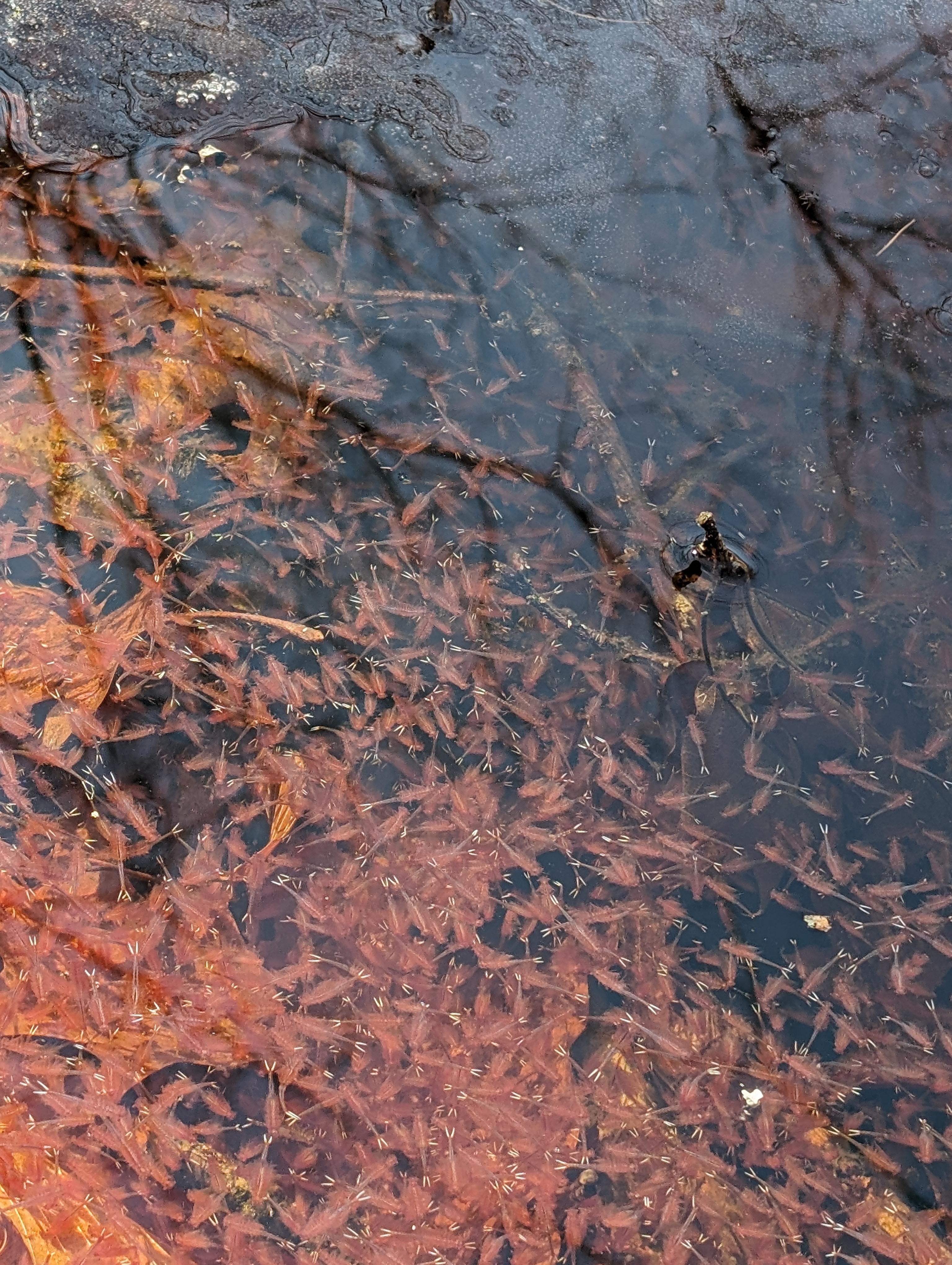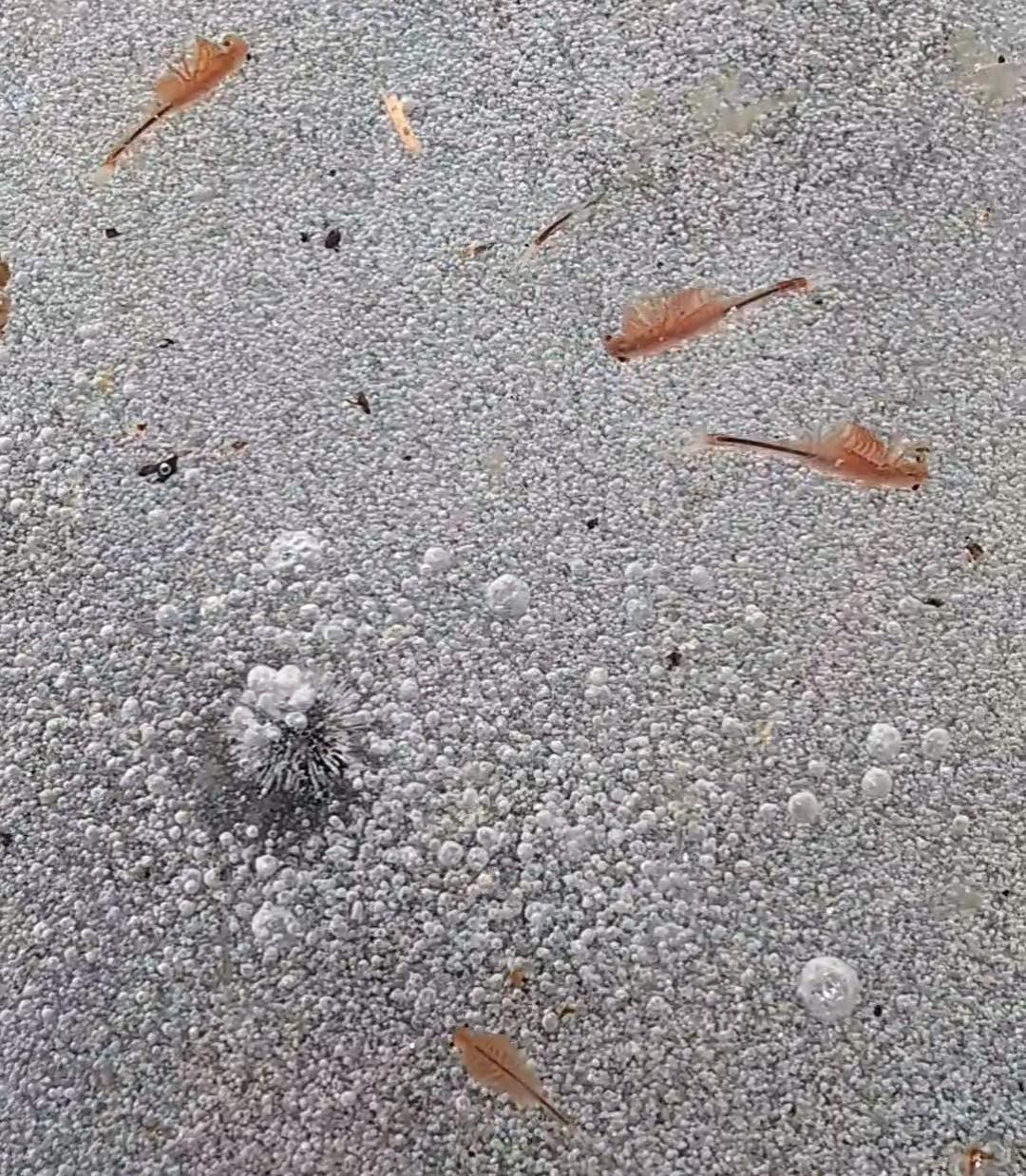- Tags:
- Wildlife,
- Forestry,
- Working Forests

The healthy population of fairy shrimp located in Goffstown
Part of the job of a forester for the Forest Society is inventorying our reservations to help us develop management plans. While conducting an inventory on a reservation in Goffstown, I found a relatively large vernal pool covered with a few inches of ice. The pool was fed by a small seep that created an open area of water, and when I looked into the one open area, there were hundreds of thousands of fairy shrimp. Having never seen these creatures before, I was amazed at the quantity of shrimp and the uniqueness of this species with very specific habitat requirements.

Fairy shrimp emerging from the ice.
Fairy shrimp, also known as brine shrimp, are crustaceans related distantly to the shrimp in the ocean, but more closely related to water fleas, clam shrimp, and tadpole shrimp. The body of the fairy shrimp resembles a slender pink stick with two black eyes, a forked tail, and too many legs to count. They spend most of their lives under ice, eating algae. The only place you can find them in New England is in certain vernal pools with cold, deep, clean water.
Vernal pools are ephemeral bodies of water ranging in size from a puddle to over an acre. The pools fill with water in late fall and winter.
Vernal pools are not connected to other bodies of water by streams, so fish are not present. This allows amphibians to use the pools as protected spawning grounds where eggs and young can survive. Turtle species, such as the Blanding's turtle, also use vernal pools while traveling overland or for wintering. One of the most unique animals to use vernal pools is the fairy shrimp, which, unlike the other species, is not amphibious and cannot survive outside of water. So how do fairy shrimp continue to exist if they can't survive the dry months? While the adults die when the pond dries up, the eggs have evolved to withstand long periods of drought.
Life Cycle
Ever get sea monkeys as a kid? Open a package of microscopic eggs and toss them in the water, and the sea monkeys will hatch within days. Within a week, the tank is full of life. Their eggs can remain alive for years in a dry state, then come alive when added to water, much like baker's yeast. Eastern fairy shrimp (Eubranchipus vernalis) are the freshwater relatives of the brine shrimp marketed as sea monkeys (Artemia sp.).
Like sea monkey eggs, they undergo a state of anhydrobiosis, derived from the Greek term for "life without water." At this point, when the ponds are completely dry, the eggs are light enough to be carried by the wind, allowing them to relocate to other bodies of water. When the pools refill with water, the eggs hatch and the population is revived as larvae. Over the winter, individuals will grow in size, going through several instar stages and adding more and more segments to their bodies. In the spring, they reach sexual maturity and reproduce, starting the cycle all over again.
Habitat requirements

The habitat requirements of the Eastern Fairy Shrimp are very specific. They require deep vernal pools that freeze over during the winter, but do not freeze completely, as much of their life is spent under the ice. The ice protects them from terrestrial predators during the winter while amphibians enter a state of brumation. This gives the defenseless and tasty shrimp time to grow without fear of predation. Other brine shrimp species do not require ice cover for their life cycle, with many species surviving in endorheic basins with bodies of water that appear during wet springs. What makes the eastern fairy shrimp unique is that it requires forest cover in addition to deep vernal pools. The forest helps shade the pools, allowing them to retain water longer into the growing season, while preventing the pools from exceeding the critical temperature of 68 F that would kill the shrimp.
Forestry and vernal pools
This requirement for clean, cold water and canopy cover over the pool drives how we manage the forest within the vernal pool basin and surrounding areas. According to Good Forestry in the Granite State, a guide to recommended practices, machinery should not be operated within the pool, slash should not be added to or removed from the pool, and operators should avoid cutting trees that overhang the pool. Within a 200-foot radius of the pool, harvesting should be limited to individual trees and small groups, understory vegetation should be left undisturbed, and heavy equipment activity should be limited. Beyond this area, scarification and ground disturbance should be limited, ground disturbance should only occur when frozen or dry, and all other typical best management practices should be followed. Properly following these guidelines will allow timber harvesting and wetland protection to coexist and continue the protection of these one of a kind animals in our state.
Further Reading
- Animal Diversity: https://animaldiversity.org/accounts/Eubranchipus_vernalis/
- Good Forestry in the Granite State: https://extension.unh.edu/goodforestry/assets/docs/GoodForestry2010FINALreducedsizeSECURE.pdf
Ben Aldrich is a field forester for the Forest Society.
